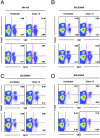Regulatory T-cell expansion during chronic viral infection is dependent on endogenous retroviral superantigens
- PMID: 21321220
- PMCID: PMC3048095
- DOI: 10.1073/pnas.1100213108
Regulatory T-cell expansion during chronic viral infection is dependent on endogenous retroviral superantigens
Abstract
Regulatory T cells (Treg) play critical roles in the modulation of immune responses to infectious agents. Further understanding of the factors that control Treg activation and expansion in response to pathogens is needed to manipulate Treg function in acute and chronic infections. Here we show that chronic, but not acute, infection of mice with lymphocytic choriomeningitis virus results in a marked expansion of Foxp3(+) Treg that is dependent on retroviral superantigen (sag) genes encoded in the mouse genome. Sag-dependent Treg expansion was MHC class II dependent, CD4 independent, and required dendritic cells. Thus, one unique mechanism by which certain infectious agents evade host immune responses may be mediated by endogenous Sag-dependent activation and expansion of Treg.
Conflict of interest statement
The authors declare no conflict of interest.
Figures






References
-
- Fontenot JD, Rudensky AY. A well adapted regulatory contrivance: Regulatory T cell development and the forkhead family transcription factor Foxp3. Nat Immunol. 2005;6:331–337. - PubMed
-
- Sakaguchi S. Naturally arising CD4+ regulatory t cells for immunologic self-tolerance and negative control of immune responses. Annu Rev Immunol. 2004;22:531–562. - PubMed
-
- Shevach EM. Mechanisms of foxp3+ T regulatory cell-mediated suppression. Immunity. 2009;30:636–645. - PubMed
-
- Bennett CL, et al. The immune dysregulation, polyendocrinopathy, enteropathy, X-linked syndrome (IPEX) is caused by mutations of FOXP3. Nat Genet. 2001;27:20–21. - PubMed
-
- Fontenot JD, Gavin MA, Rudensky AY. Foxp3 programs the development and function of CD4+CD25+ regulatory T cells. Nat Immunol. 2003;4:330–336. - PubMed
Publication types
MeSH terms
Substances
Grants and funding
LinkOut - more resources
Full Text Sources
Other Literature Sources
Molecular Biology Databases
Research Materials

